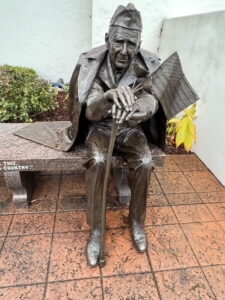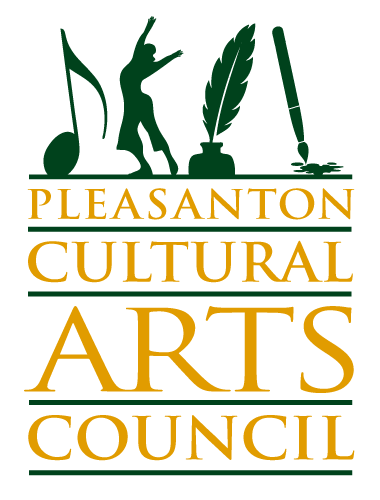Poppies
 Bent with age but honored by service, a life-size bronze sculpture of a veteran sits on a 7-foot granite bench, gazing into an unforeseen tomorrow. He compels all to remember proud sacrifice as they enter the 1933 Veterans Memorial Building, VFW Post 6298 at 301 Main Street, Pleasanton. His extended hands are braced on a cane holding a flag and two poppies reminiscent of the red poppies that were among the first plants to bloom in the devastated battlefield of northern France and Belgium in WW I. The flowers reflect the famous poem “In Flanders Fields”, pleading with survivors to take up the fight and remember their sacrifice is not in vain. His clapped hands hold a small American flag, frozen in a silent breeze.
Bent with age but honored by service, a life-size bronze sculpture of a veteran sits on a 7-foot granite bench, gazing into an unforeseen tomorrow. He compels all to remember proud sacrifice as they enter the 1933 Veterans Memorial Building, VFW Post 6298 at 301 Main Street, Pleasanton. His extended hands are braced on a cane holding a flag and two poppies reminiscent of the red poppies that were among the first plants to bloom in the devastated battlefield of northern France and Belgium in WW I. The flowers reflect the famous poem “In Flanders Fields”, pleading with survivors to take up the fight and remember their sacrifice is not in vain. His clapped hands hold a small American flag, frozen in a silent breeze.
Perhaps he is sitting on this bench after a Veteran’s Day Parade. His military dress reflects the formal clothing of a VFW member. An overcoat with eagle service buttons drapes over his shoulders revealing an army uniform jacket. The US symbol is on his right lapel; the crossed canons insignia of the artillery are on his left lapel. Across his chest are three medals. The heart-shaped badge inscribed with the likeness of George Washington is awarded by the President to those wounded in action or killed. In 1932 the “Badge of Military Merit” became known as the Purple Heart. The star-shaped medal is for heroism, perhaps a silver or bronze star. The last decoration is a WWII Field Service medal. His deeply furrowed forehead anchors a ceremonial hat with the word California, a Post number, and a VFW insignia. His gaze is penetrating, reflecting the brotherhood of military service and the cost of preserving our freedom.
Artist W. Stanley “Sandy” Proctor is a Tallahassee, Florida native who has earned a national reputation as a professional sculptor of the highest caliber. The self-taught artist began his career as a painter but soon was drawn into the 3-D world, sculpting clay, alabaster, and marble. He is best known for his work in bronze. Proctor strives “to capture all my subject matter’s emotion, personality, grace, and honor.” The model for the sculpture was his own first cousin, Julian, and remains ‘near to his heart’.
Gary and Nancy Harrington saw “Poppies” at a gallery in Sedona, Arizona, and acquired it. It was the first piece of public art donated to Pleasanton by the Harringtons and installed in 2007. Its acquisition started the Harrington Art Partnership with the City of Pleasanton. The bench was donated by Pleasanton resident, Bob Mattos and reads “Greater love hath no man than this, that a man lay down his life for his country.”
The plaque on the short wall next to Poppies reads, “Dedicated to the men and women who so nobly and generously serve our country.” Harrington’s gift immortalizes and reflects a universal brotherhood of service to our country. It cautions us, above all…. remember.
Jan Coleman-Knight
